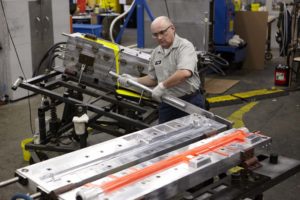 Material selection is a vital aspect when it comes to producing cast polyurethane components. However, once the material is selected, more design work takes place to actually produce the cast polyurethane part.
Material selection is a vital aspect when it comes to producing cast polyurethane components. However, once the material is selected, more design work takes place to actually produce the cast polyurethane part.
With a cast polyurethane manufacturer, the process for any cast urethane component begins with mold design.
Mold design is important in order for the parts to be produced efficiently and according to the engineering drawing. The cast polyurethane process is beneficial to the end user because the molds can be produced at relatively low cost. Since the material is placed in the mold at atmospheric pressure, the mold cavity does not need to stand up to the incredible internal pressures common to injection, compression or transfer molding.
Tooling for the cast urethane process can be made from metals, polyurethane, or silicone. Due to its rigidity and relatively low coefficient of thermal expansion, metal is a great choice for parts requiring tight tolerances.
Polyurethane itself can be used to mold cast polyurethane because it is a thermoset material. The polyurethane mold will not melt when liquid urethane is placed against it. Urethane molds are great for high volume production and part tolerances that aren’t as critical.
Silicone molds are beneficial for prototyping because they can only be used once or twice before the mold cavity needs to be remade.
 When designing a mold for cast polyurethane there are three factors that must be kept in mind for the mold to produce good parts.
When designing a mold for cast polyurethane there are three factors that must be kept in mind for the mold to produce good parts.
- It’s important that the mold can be filled without causing excessive turbulence in the liquid raw material. Turbulence entraps air that will result in bubble-like voids in the finished product.
- Mold release must be applied evenly to all surfaces of the mold that will come in contact with the product. If mold release can’t be applied evenly and it is allowed to pool in certain areas of the mold, the surface finish on the part will suffer.
- The cured urethane part must easily be removed from the mold. If the part can’t be removed easily from the mold cavity then there is an increased risk for decreased production volume, mold damage or part distortion.
Aside from careful tooling design, the handling and processing of the raw materials is important for producing high-quality polyurethane components.
All elastomers produced at Gallagher Corporation start out as liquid raw materials. The solid elastomers are formed when a Prepolymer is mixed with a curative and left to cure in the presence of heat. Heat is a catalyst that speeds up the chemical reaction between the reactive groups in the Prepolymers and the curative.
While heat is vitally important to the efficient operations at Gallagher, if not kept in check it can cause degradation in the Prepolymers. As a quality cast polyurethane manufacturer, Gallagher performs titrations on its Prepolymers every day to check and monitor the level of heat aging that has occurred. By doing this, the mix ratio between Prepolymer and curative can be adjusted so that every part produced by Gallagher will be identical in terms of material properties.
 Aside from heat aging, Gallagher takes great care to ensure only the highest quality raw materials are used in its products. The raw materials must be properly degassed and kept extremely dry to reach peak performance. Evidence of entrapped gases or moisture is difficult to see with the naked eye on a finished part. It typically shows up as tiny bubbles or voids in the finished elastomer. These tiny bubbles can greatly reduce the tear strength and ultimate elongation of the cured elastomer.
Aside from heat aging, Gallagher takes great care to ensure only the highest quality raw materials are used in its products. The raw materials must be properly degassed and kept extremely dry to reach peak performance. Evidence of entrapped gases or moisture is difficult to see with the naked eye on a finished part. It typically shows up as tiny bubbles or voids in the finished elastomer. These tiny bubbles can greatly reduce the tear strength and ultimate elongation of the cured elastomer.
Gallagher controls these things by utilizing computer controlled meter-mix elastomer processing equipment. These machines hold the raw materials under vacuum until they are needed. Once the material is needed the machine meters out precise weights of Prepolymer and curative and mixes them together under high shear. Getting the ratio of Prepolymer to curative correct is important to the final performance of the elastomer. A small error in ratio control could result in drastic material property changes in the final part.
Another important detail in producing high-quality cast urethane components is the mold heat source. Molds can be heated in a variety of ways. At Gallagher Corporation, molds are heated in forced air convection ovens and on steam heated platens. Large molds are gun drilled and heated with hot oil. As the liquid urethane cures, it shrinks. The shrinkage is a result of chemical shrinkage due to the aligning of molecules and also thermal shrinkage as the part is cooled to room temperature after curing takes place. Tight control over molding temperatures is necessary to maintain consistent dimensional tolerance. If mold temperature were to change from one size to the next, part size would change as well.
Finding a cast polyurethane manufacturer partner who can help you through the process of designing, prototyping, and producing your parts is critical to your success. Gallagher Corporation has been providing quality parts for its OEM partners for over 60 years. Speak to our team of cast polyurethane experts when looking to design a part that will meet your needs.

